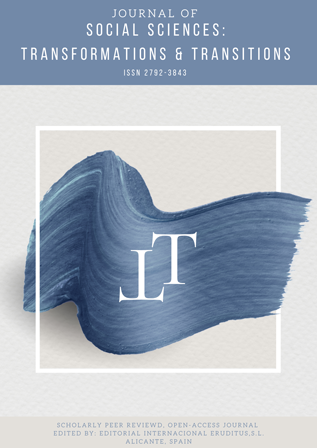Social Perspective about the Evolution of a Cultural Asset as a World Heritage Site. Case Study: The Palmeral of Elche
DOI:
https://doi.org/10.52459/josstt24140422Keywords:
Cultural Heritage, Identity, Palmeral of Elche, Touristic CommunicationAbstract
Cultural heritage has become a touristic attraction, especially those elements recognized as World Heritage Sites, generating great growth in the cultural tourism sector during recent decades. Given the importance of this phenomenon, the purpose of the following research is to analyze the tourism-heritage impact of the UNESCO organization within a specific World Heritage Site. In this case, the study is focused on The Palmeral of Elche (Alicante, Spain), an oasis-type irrigated agro-system recognized as a Cultural Site by UNESCO in 2000. To carry out this analysis, a theoretical review and a qualitative methodology have been implemented. The techniques used were participant observation, creation of thematic mapping, and in-depth interviews with different social agents linked to this cultural landscape from the Al-Andalus period. As a conclusion, possible responsible and sustainable actions have been determined within the social, heritage and tourist framework.
Bilingual Publication: The original version in Spanish is available in the PDF file.
Metrics
References
Alemañ, G. (2016). El palmeral histórico de la ciudad de Elche y su acequia mayor: Análisis patrimonial y afecciones urbanísticas generadas [Tesis doctoral inédita]. Universidad de Alicante. http://hdl.handle.net/10045/59870
Ariño, A. (2012). La patrimonialización de la cultura y sus paradojas postmodernas. En C. Lisón (ed.), Antropología: Horizontes Patrimoniales, 209-230. Tirant lo Blanch.
Ballesteros, M. (2015). The Palmeral of Elche: an urban irrigation landscape. E-Phaïstos, IV-2, 36-48. https://doi.org/10.4000/ephaistos.742
Bosque, J. (2014). Patrimonio turístico e identidad cultural. El Patrimonio de la Humanidad. Polígonos. Revista de Geografía, (5), 173-180. https://doi.org/10.18002/pol.v0i5.1137
Bracamonte, R. (2015). La observación participante como técnica de recolección de información de la investigación etnográfica. Revista Arjé, 17(9), 132-139. http://www.arje.bc.uc.edu.ve/arj17/art11.pdf
Bustos, R. (2004). Patrimonialización de valores territoriales. Turismo, sistemas productivos y desarrollo local. Aportes y Transferencias, 8(2), 11-24. https://www.redalyc.org/pdf/276/27680202.pdf
Cárdenas, C. (2012). Importancia de la protección del patrimonio cultural. Investigaciones sociales, 16(29), 257-265. https://doi.org/10.15381/is.v16i29.7806
Cardinale Baptista, M.ª L. (2014). Cartografia de Saberes na Pesquisa em Turismo: Proposições Metodológicas para uma Ciência em Mutação. Revista Rosa dos Ventos – Turismo e Hospitalidade, 6(3), 342-355. http://www.ucs.br/etc/revistas/index.php/rosadosventos/article/view/2647/pdf_273
Cardinale Baptista, M.ª L. (2017). Trama mediática y subjetiva y responsabilidad ecosistémica en el Turismo. Estudios Turísticos, 211-212, 43-55. https://turismo.janium.net/janium/Objetos/REVISTAS_ESTUDIOS_TURISTICOS/03%20trama%20mediatica.pdf
Carmona, D., Travé, R., & Nogués, A. (2015). Los misterios del patrimonio y el turismo en Elche. Lo global (Unesco) en lo local (identidad). Revista Andaluza de Antropología, (8), 113-140. http://dx.doi.org/10.12795/RAA.2015.i08.06
Consejo de Europa (2000). Convención Europea del Paisaje. Congreso de Autoridades Locales y Regionales de Europa. European Treaty Series (ETS) 176. https://rm.coe.int/16807b6bc7
Cremades, V. J. (2009). Protección y tutela normativa de “El Palmeral de Elche”. Revista de la Facultad de Ciencias Sociales y Jurídicas de Elche, 1(4), 82-109.
Endere, M. L. (2009). Algunas reflexiones acerca del patrimonio. En M. L Endere y J. L. Prado (eds.), Patrimonio, ciencia y comunidad. Su abordaje en los partidos de Azul, Olavarría y Tandil, 19-48. Olavarría, Argentina: INCUAPA, UNCPBA. https://www.academia.edu/download/31676527/Cap.01-Endere.pdf
Fernández, V. (2008). La protección del Patrimonio Mundial en España. E-RPH, 2, 1-30. http://hdl.handle.net/11441/67219
García, M. P. (2012). El patrimonio cultural. Conceptos básicos. Prensas Universitarias de Zaragoza.
Hernández-Ramírez, J., & Quintero-Morón, V. (2019). L’efecte UNESCO. Gestió turística o gestió patrimonial dels Patis de Còrdova? Revista d'etnologia de Catalunya, (44), 76-93. https://www.raco.cat/index.php/RevistaEtnologia/article/view/371137
Huerto del Cura. (s.f.). Jardín Artístico Nacional Huerto del Cura. https://www.huertodelcura.com/
ICOMOS - Consejo Internacional de Monumentos y Sitios. (2008). Carta ICOMOS para Interpretación y Presentación de Sitios de Patrimonio Cultural. ICOMOS. https://www.icomos.org/images/DOCUMENTS/Charters/interpretation_sp.pdf
Larrosa, J. A. (2003a). El Palmeral de Elche. Evolución reciente y función turística después de su declaración como Patrimonio de la Humanidad. Ciudad y Territorio: Estudios Territoriales, (135), 127-154. https://recyt.fecyt.es/index.php/CyTET/article/view/75314
Larrosa, J. A. (2003b). El palmeral de Elche: patrimonio, gestión y turismo. Investigaciones Geográficas, (30), 77-96. https://doi.org/10.14198/ingeo2003.30.04
Ley 1/1986, 9 de mayo, por la que se regula la tutela del Palmeral de Elche. Boletín del Estado, 139, de 11 de junio de 1986. https://www.boe.es/buscar/pdf/1986/BOE-A-1986-15303- consolidado.pdf
Ley 14/2003, 10 de abril, de Patrimonio de la Generalitat Valenciana. Boletín del Estado, 122, de 22 de mayo de 2003. https://www.boe.es/buscar/pdf/2003/BOE-A-2003-10298-consolidado.pdf
Martínez, L. P. (2003). El Palmeral de Elche: un paisaje cultural heredado de Al-Ándalus. Ajuntament d'Elx. http://www.elche.me/sites/default/files/palmeral_elche.pdf
Martínez, L. P. (2006). Tangible e intangible. Reflexiones acerca de la cultura del agua y el patrimonio de la humanidad en Elche. Imafronte, (18). https://revistas.um.es/imafronte/article/view/36411
Mejía, J. (2004). Sobre la investigación cualitativa. Nuevos conceptos y campos de desarrollo. Investigaciones Sociales, 8(13), 277-299. https://doi.org/10.15381/is.v8i13.6928
Molano, O. L. (2007). Identidad cultural un concepto que evoluciona. Revista Opera, (7), 69-84. https://dialnet.unirioja.es/servlet/articulo?codigo=4020258
OMT - Organización Mundial del Turismo. (2019). Definiciones de turismo de la OMT. OMT. https://doi.org/10.18111/9789284420858
Patronato de El Palmeral de Elche. (2013). Censo del Palmeral Histórico de Elche 2013. Ajuntament d’Elx. http://palmeralelx.umh.es/files/2014/06/12-Censo-palmeras-Maite- ayunt-Elche.pdf
Prats, Ll. (1998). El concepto de patrimonio cultural. Política y Sociedad, (27), 63-76. http://revistascientificas.filo.uba.ar/index.php/CAS/article/view/4709
Prats, Ll. (2006). La mercantilización del patrimonio: entre la economía turística y las representaciones identitarias. PH Boletín del Instituto Andaluz del Patrimonio Histórico, 58, 72-80. https://doi.org/10.33349/2006.58.2176
Prats, Ll. (2011). La viabilidad turística del patrimonio. PASOS. Revista de Turismo y Patrimonio Cultural, 9(2), 249-264. https://doi.org/10.25145/j.pasos.2011.09.023
Proyecto de Ley de Protección y Promoción del Palmeral de Elche. Bulletí Oficial de les Corts Valencianes, 29.230, de 21 de enero de 2021. https://www.cortsvalencianes.es/sites/default/files/initiative/doc/elche.pdf
RAE - Real Academia Española. (s.f.). Patrimonio. En Diccionario de la lengua española. https://dle.rae.es/patrimonio?m=form
Sagasta, J., & Pineda, E. (2012). La gestión del Palmeral de Elche. En C. Barciela, M. I. López, J. Melgarejo (eds.), Los bienes culturales y su aportación al desarrollo sostenible, 589- 612. Universidad de Alicante. http://www.daea.ua.es/heritechs/pdf/PinedaSegarrra.pdf
Sánchez Garrido, R. (2012). Patrimonio y paisaje: el Palmeral de Elche. En S. Gallego Trijueque & E. Díaz Cano (coords.), XI Premio de Ensayo Breve “Fermín Caballero” (pp. 33-62). ACMS.
Silva, R., & Fernández, V. (2015). Los paisajes culturales de Unesco desde la perspectiva de América Latina y el Caribe: Conceptualizaciones, situaciones y potencialidades. Revista INVI, 30(85), 181-214. https://dx.doi.org/10.4067/S0718-83582015000300006
UN – Naciones Unidas (s.f.). Objetivos de Desarrollo Sostenible (ODS). United Nations. https://www.un.org/sustainabledevelopment/es/
UNESCO - Organización de las Naciones Unidas para la Educación, la Ciencia y la Cultura. (1954). Convención para la Protección de los Bienes Culturales en caso de Conflicto Armado. UNESCO. http://portal.unesco.org/es/ev.php- URL_ID=13637&URL_DO=DO_TOPIC&URL_SECTION=201.html
UNESCO - Organización de las Naciones Unidas para la Educación, la Ciencia y la Cultura. (1970). Convención sobre las Medidas que Deben Adaptarse para Prohibir e Impedir la Importación, la Exportación y la Transferencia de Propiedades Ilícitas de Bienes Culturales. UNESCO. http://portal.unesco.org/es/ev.php- URL_ID=13039&URL_DO=DO_TOPIC&URL_SECTION=201.html
UNESCO - Organización de las Naciones Unidas para la Educación, la Ciencia y la Cultura. (1972). Convención sobre la protección del patrimonio mundial, cultural y natural. UNESCO https://whc.unesco.org/archive/convention-es.pdf
UNESCO - Organización de las Naciones Unidas para la Educación, la Ciencia y la Cultura. (1977). Directrices Operativas para la aplicación de la Convención del Patrimonio Mundial. UNESCO. https://whc.unesco.org/archive/opguide77b.pdf
UNESCO - Organización de las Naciones Unidas para la Educación, la Ciencia y la Cultura. (1992). Informe del Grupo de Expertos en Paisajes Culturales. La Petit Pierre (France) 24-26 de octubre de 1992. UNESCO. http://whc.unesco.org/archive/pierre92.htm
UNESCO - Organización de las Naciones Unidas para la Educación, la Ciencia y la Cultura. (2008). Carpeta de información sobre el Patrimonio Mundial. UNESCO. https://whc.unesco.org/document/102074
UNESCO - Organización de las Naciones Unidas para la Educación, la Ciencia y la Cultura. (2019). Directrices Operativas para la aplicación de la Convención del Patrimonio Mundial. UNESCO. https://whc.unesco.org/en/guidelines
Downloads
Published
License
Copyright (c) 2022 Ana IRLES-QUIRANT, María-Teresa RIQUELME-QUIÑONERO

This work is licensed under a Creative Commons Attribution 4.0 International License.










